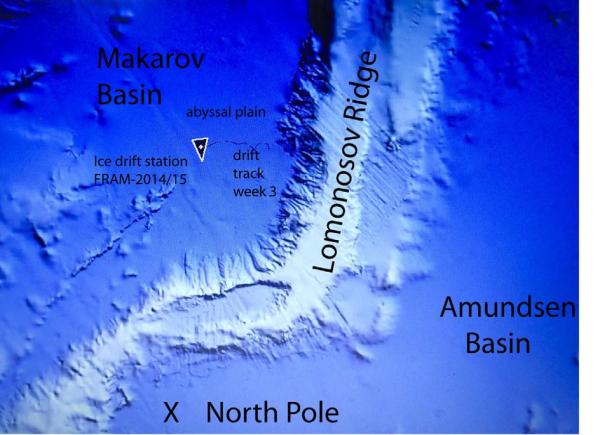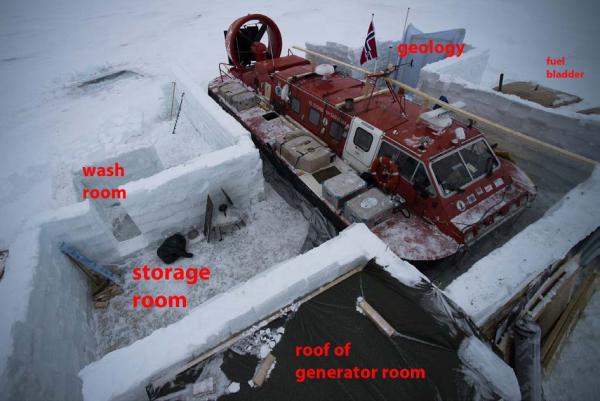(15 - 21 Sept. 2014)
Ice drift and camp life
The ice drift during the week has been 33 nautical miles (60 km) due east - a direction which is roughly perpendicular to the long term direction of ice drift. High winds during Thursday 18 Sept. reached 35 knots (Strong Gale, Beaufort 7) with blowing snow and the ice moved at 0.4 knots (1 km/hour). This ice motion has been driven by winds from the sector between South and West associated with a persistent high pressure between Alaska and the North Pole. To us, this ice drift is nothing but a huge benefit so far for two reasons; 1) it gives us time to build a camp for the winter, and 2) it takes us into the deep Makarov Basin across a linear trend of buried seamounts and ridges which are considered to be a large shear zone - a key element in the formation of the oldest part of the Arctic Ocean. We could not do better even if we were in command of an icebreaker.
Getting the ice hangar finished has been given priority and occupied us all week. By Saturday, we had completed a total of 42 meter length of 2 meter high and 40 cm thick walls (see picture), only the bath room walls are still unfinished. The main hangar was covered by a tarp on Sunday and left us too tired for any report writing. By next week, the winter camp will be completely finished and more particulars will be given.
On Friday after lunch, we moved 3 tons of fuel from the depot to a new location. This was done by pumping the fuel into the long range fuel tanks of the hovercraft, taking the empty fuel bladders on deck and later pumping the fuel back into the bladder on the ice at the new location, one ton at a time.
The temperatures during the week have been mostly between minus 5 and minus 8 Centigrades because we have had persistent overcast and low clouds. Once the sky clears up as in the morning of Wednesday 17 Sept., the temperature dropped by minus 10 Centigrades within a few hours. Even if the hovercraft keels sit on pallets over 20 centimeters above the ice, the warm weather gives us problems. The heath from the hull below the cabin part of the hovercraft melts the ice below and the front sinks in. This week we had to do another build up of support and also create openings for influx and circulation of cold air below the hull.
"We are under-staffed", Audun remarked shortly after Polarstern had left us; "we should have been six persons". Of course he was right, but the reality is that an operation like that would never become a reality because of costs. The penalty is during the start-up phase as it will take us more than three weeks to get the camp and working conditions in order. Once we are there, two persons are enough.
The sun went below the horizon at midnight during this week - we have no more midnight sun. Because of the persistent low clouds, there is not much difference between the light during day and night. Under these white-out conditions, there is almost no contrast in the landscape around us. We are acutely aware of that at times it would be very difficult to spot a white polar bear before the animal is something like 50-100 meter away.
Science
With the Acoustic Doppler Current Profiler deployed on Sunday, Sept. 14th, we are continuously scanning the depth range from surface to 500 meter depth for the velocity of ocean currents. Beyond that we have a current meter hanging from the ice at 800 meter depth and another one at 2000 m depth. The instruments for measuring incoming and outgoing radiation are running, but needs to be inspected for removal of ice from the sensors several times a day. The 3.5 kHz echo sounder gives about 20 meter of sub-bottom penetration, and five remote autonomous echo sounding buoys provides supplementary bathymetry data. With ice hangar up, priority will be given to getting the seismic gear up and running.
We are drifting over the abyssal plain in the Makarov Basin. The dimensions and properties of abyssal plains are spectacular features and manifestations of physical processes in the deep sea. We have drifted over 60 km into the Makarov Basin and the water depth has increased steadily less than 5 meters. In the global ocean, this is a small abyssal plain and we are less than halfway across it. Sediments are deposited in the deep ocean at a rate of about 1 cm per. thousand years in two principal ways; i) as fall-out from the biogenic production in the surface waters, or ii) brought in by sediment laden (turbidity) currents. The biogenic sediments produce an even drape of sediments over highs and lows, while deposits by turbidity currents are gravity flows which always seek the lowest areas and create a vast plain. Turbidite deposition dominates if an abyssal plain is adjacent to sediments sources on a continental slope; in this case the continental margin of the East Siberian Sea. In this way the shape of the sea bottom of the abyssal plain will always be perpendicular to the Earth's gravitational attraction in the same way as the sea surface; they are equi-potential surfaces.
No form of animal life has been observed during the week.
All is well.
Yngve Kristoffersen & Audun Tholfsen
Daily reports
Monday 15 September.
Position: 87 22.9' N, 161 41' E, temperature - 5 C, air pressure 1014 hPa, wind 10 knots from NNE. Worked all day cutting ice blocks and building the storage room. Hovercraft skirt segments were partly frozen in and had to be freed and strapped up.
Radiation instrument checked twice for icing and IR skin temperature sensor brought in for cleaning and mounted back again.
Tuesday 16 September.
Position: 87 21.1' N, 163 50' E, temperature - 10 C, air pressure 1018 hPa, wind 7 knots from SW. White-out. Ice drift 0.2 knots due East. North and east wall of storage room completed.
Wednsday 17 September.
Position: 87 20' N, 164 13' E, temperature - 14 C, air pressure 1020 hPa, wind 8 knots from SE. Ice drift 0.2 knots towards East. Two walls on the wash room nearly completed. Moved the generator into the new generator room. Winds increased during the evening and by 1800 hours we stopped because of blowing snow.
Thursday 18 September.
Position: 87 21' N, 168 04' E, temperature - 5 C, air pressure 1015 hPa, wind 20 knots from SSE. Ice drift 0.4 knots towards ENE. Wind increased with gusts reaching 35 knots at 1500 hours and drifting snow, but came down to 18 knots one hour later. Later wind speeds about 20 knots. Removed ice from the radiation flux instruments twice during the day. Covered the new generator room with a tarp and tore down the old small shed.
Friday 19 September.
Position: 87 23.8' N, 169 45' E, temperature - 6 C, air pressure 1021 hPa, wind 10-14 knots from SE. Ice drift 0.3 knots towards ENE. Started cleaning up after the snow storm. Prepared and moved the hovercraft out of the hangar by using the winch. Pumped fuel from 3 fuel bladders into the long range tanks of the hovercraft, put the bladder on deck and moved to the vicinity of the hangar where the fuel was pumped back into the bladders. Moved 1 ton at a time. The parking stand inside the hangar had sunk and needed to be padded with more 2"x4". Also, the wall opening into the hangar had to be reinforced as two meters of wall was knocked over while docking the hovercraft in side wind. Removed ice from radiation instruments twice during the day.
Saturday 20 September.
Position: 87 26.2' N, 171 10' E, temperature - 5 C, air pressure 1030 hPa, wind 2 knots from the S. Ice drift 0.1 knots towards NE. Worked on ice walls for the wash room. Checked radiation flux instrument three times for ice.
Sunday 21 September.
Position: 87 26.5' N, 171 36' E, temperature - 8 C, air pressure 1030 hPa, wind 4 knots from S. Worked on putting a tarp over the 80 square meter main hangar. We were pleased with the result. Checked radiation flux instruments for ice twice.

Our drift track (thin line) during the third week of ice drift. The length of the track is about 60 km.

Overview of the ice hangar and adjacent rooms.
